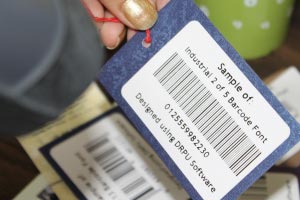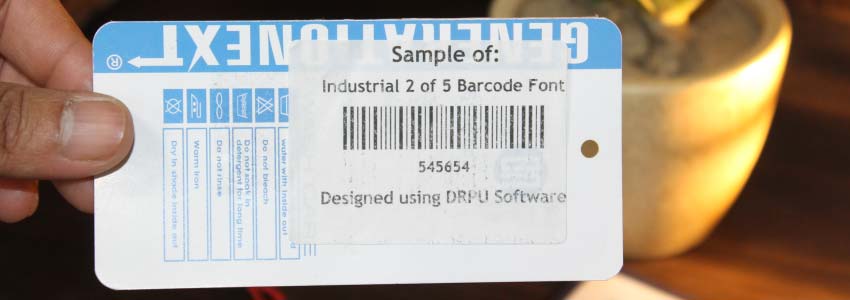Scan, Usage, and Cost of Industrial 2 of 5 Barcode
Scanning an Industrial 2 of 5 barcode is a quick and easy process, but there are some important factors to consider to ensure that the barcode can be read accurately by a barcode scanner. In this article, we will discuss how to scan an Industrial 2 of 5 barcode, the equipment you need, and some tips for optimizing the scanning process.

Scan an Industrial 2 of 5 Barcode
Equipment:
To scan an Industrial 2 of 5 barcode, you will need the following equipment:
-
Barcode Scanner:
A barcode scanner is a handheld device that can read the barcode image and convert it into digital data. There are several types of barcode scanners available, including handheld, cordless, and fixed-mount scanners. It is important to choose a barcode scanner that is compatible with the type of barcode you are scanning.
-
Barcode Label:
The barcode label is the printed label that contains the Industrial 2 of 5 barcode image. It is important to ensure that the label is printed correctly and is free from any damage or distortion that could affect the readability of the barcode.
Scanning Process:
To scan an Industrial 2 of 5 barcode, follow these steps:
- Turn on the barcode scanner and point it at the barcode label.
- Position the scanner so that the barcode label is in the center of the scanner's field of view.
- Press the trigger or scan button on the scanner to activate the scanner.
- Wait for the scanner to beep or indicate that it has successfully scanned the barcode.
- Check the scanner's display or output to ensure that the correct data has been captured.
Types of Devices Can Read Industrial 2 of 5 Barcode
-
Barcode Scanners:
Barcode scanners are devices specifically designed for reading barcodes, including Industrial 2 of 5 barcodes. There are several types of barcode scanners available, including handheld, fixed-mount, and cordless scanners. These scanners use various methods to read the barcode, such as laser scanning or image-based scanning, and they are capable of reading barcodes at different distances and angles.
Handheld scanners are the most common type of barcode scanner and are ideal for applications where mobility is required. They are easy to use, affordable, and can read barcodes from a few inches to several feet away. Fixed-mount scanners are typically used in automated systems and are stationary devices that can read barcodes as they pass by. Cordless scanners are similar to handheld scanners but have the added advantage of being able to communicate with a computer or mobile device wirelessly.
-
Software Applications:
Software applications can also be used to read Industrial 2 of 5 barcodes. These applications run on a computer and use a webcam or specialized scanner to read the barcode image. The software then decodes the data encoded in the barcode and transfers it to a database or other system.
Software-based barcode scanning is ideal for applications where barcodes need to be scanned in bulk, such as inventory management or shipping and receiving. However, the cost of specialized hardware and software can be higher than other barcode scanning solutions.
-
Smartphones:
Smartphones can also be used to read Industrial 2 of 5 barcodes. Most modern smartphones have built-in cameras and can use specialized software applications to read barcodes. These apps use the camera to scan the barcode image and then decode the data encoded in the barcode. There are many barcode scanning apps available for both iOS and Android devices, and they can be downloaded for free or for a nominal fee.
Smartphone-based barcode scanning is convenient because most people carry a smartphone with them at all times. However, smartphone-based scanning has some limitations. For example, the camera quality and lighting conditions can affect the accuracy of the scanning process. Additionally, the scanning range is typically limited to a few inches, which can be a problem when scanning barcodes from a distance.
Conclusion:Industrial 2 of 5 barcodes can be read by a wide range of devices, including barcode scanners, smartphones, and software applications. Each type of device has its advantages and limitations, and the choice of device will depend on the specific application requirements. Barcode scanners are the most common and reliable devices for reading barcodes, while smartphones and software applications are convenient and cost-effective alternatives.
International Usage of Industrial 2 of 5 Barcode
Industrial 2 of 5 barcodes can be used internationally, but there are some limitations and considerations to keep in mind. In this article, we will discuss the factors that affect the international use of Industrial 2 of 5 barcodes, including barcode standards, language support, and global regulations.

-
Barcode Standards:
Barcode standards vary by country, and some countries have their own barcode standards that are different from those used in other countries. For example, the United States and Canada use the Uniform Product Code (UPC) barcode standard, while Europe and other parts of the world use the International Article Number (EAN) barcode standard. However, Industrial 2 of 5 barcodes are a universal standard and can be used in any country, provided that the barcode scanner is capable of reading them.
-
Regulations:
Regulations can also affect the international use of Industrial 2 of 5 barcodes. Some countries have regulations that require specific barcode standards or barcode formats, which can limit the use of Industrial 2 of 5 barcodes. For example, some countries require the use of the EAN-13 barcode standard for product identification. Additionally, some industries have specific regulations for barcode labeling, such as the pharmaceutical industry, where regulations require certain information to be included in the barcode.
-
Language Support:
Another consideration for international use of Industrial 2 of 5 barcodes is language support. Industrial 2 of 5 barcodes are primarily used to encode numeric data, so they may not be suitable for applications where text or other characters need to be encoded. Additionally, some languages use characters that are not supported by Industrial 2 of 5 barcodes, which can be a problem for international applications. However, most barcode scanners and software applications can support multiple languages and character sets, so this may not be a significant issue.
Another regulatory consideration for international use of Industrial 2 of 5 barcodes is compliance with local laws and regulations. Some countries have strict data privacy laws that may restrict the use of certain types of barcodes or require specific security measures to be in place. Additionally, some countries may require the use of specific barcode symbologies or formats for certain applications, such as shipping and logistics.
Conclusion: Industrial 2 of 5 barcodes can be used internationally, but there are several factors to consider. Barcode standards, language support, and regulations can all affect the international use of Industrial 2 of 5 barcodes. While Industrial 2 of 5 barcodes are a universal standard, they may not be suitable for applications where text or other characters need to be encoded. Additionally, compliance with local laws and regulations is essential for successful international use of Industrial 2 of 5 barcodes. Overall, careful consideration of these factors can help ensure the successful use of Industrial 2 of 5 barcodes in international applications.
Cost Implementing of Industrial 2 of 5 Barcode
The cost of implementing Industrial 2 of 5 barcodes can vary depending on several factors, including the equipment and software needed, the size of the implementation, and the expertise of the implementation team. In this article, we will discuss the various costs associated with implementing Industrial 2 of 5 barcodes and provide some tips for reducing costs.
-
Equipment Costs:
⯮ One of the primary costs associated with implementing Industrial 2 of 5 barcodes is the cost of the equipment needed. This can include barcode scanners, printers, labels, and software. The cost of these items can vary widely, depending on the quality and features of the equipment.
⯮ Barcode scanners are one of the most critical pieces of equipment needed for Industrial 2 of 5 barcode implementation. These can range in cost from around $50 for a basic handheld scanner to several thousand dollars for a high-end, fixed-mount scanner. The type of scanner needed will depend on the application and the environment in which it will be used.
⯮ Barcode printers are also essential for creating labels for Industrial 2 of 5 barcodes. The cost of these can range from a few hundred dollars for a basic desktop printer to several thousand dollars for an industrial-grade printer. The cost of the printer will depend on the volume and complexity of the labels needed.
⯮ Labels are another necessary item for Industrial 2 of 5 barcode implementation. The cost of these will depend on the size and complexity of the label, as well as the type of material used. Labels can cost as little as a few cents each for basic paper labels to several dollars each for specialized materials like RFID tags.
-
Software Costs:
In addition to hardware costs, software is also necessary for Industrial 2 of 5 barcode implementation. This can include barcode design software, label printing software, and inventory management software. The cost of this software can range from a few hundred dollars for basic applications to tens of thousands of dollars for high-end, enterprise-level software.
-
Implementation Costs:
Another significant cost associated with Industrial 2 of 5 barcode implementation is the cost of implementing the system. This can include the cost of consultants, training, and support. The cost of implementation will depend on the complexity of the system, the size of the organization, and the expertise of the implementation team.
Tips for Reducing Costs:
While implementing Industrial 2 of 5 barcodes can be costly, there are several ways to reduce costs. One way to save money is to choose equipment and software that meets the organization's needs without being overly complex or expensive. It is also essential to consider the long-term costs of maintenance and support when selecting equipment and software.
Another way to reduce costs is to work with a reputable implementation team that has experience with Industrial 2 of 5 barcode implementation. This can help ensure that the system is set up correctly and that any issues that arise can be addressed quickly and efficiently.
Finally, organizations can save money by investing in training for employees who will be using the system. This can help reduce the likelihood of errors and improve efficiency, which can save money in the long run.
Conclusion: The cost of implementing Industrial 2 of 5 barcodes can vary widely depending on the equipment and software needed, the size of the implementation, and the expertise of the implementation team. While implementing Industrial 2 of 5 barcodes can be costly, there are ways to reduce costs, including choosing equipment and software wisely, working with an experienced implementation team, and investing in employee training. Ultimately, the benefits of implementing Industrial 2 of 5 barcodes, including improved efficiency and accuracy, can far outweigh the initial costs.